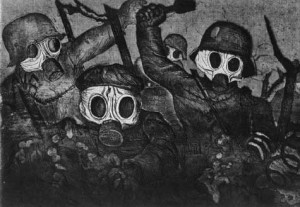Back in the day, being a socially committed graphic artist was a particularly dangerous undertaking.
Honoré Daumier was imprisoned for his work, and died impoverished. Käthe Kollwitz and Otto Dix had their work declared “degenerate” by the Nazis. George Grosz was arrested for allegedly insulting the German army. And so incendiary were Francisco Goya’s masterpieces, Disasters of War, the aquatint prints were not published until 35 years after his death.
“In the past, the documentation of these artists had a terrific effect, which was why back then it was more dangerous to do it,” says Manny Kirchheimer, director of Art Is: The Permanent Revolution, a new documentary about politicized graphic artists.

An occasional look at movies that matter.
“At least the establishment thought [these works were dangerous],” he continues. “They jailed these people, or sent them into exile.”
Kirchheimer’s film, currently in New York and soon to open around the country, operates on two levels. It is first a look at three graphic artists — etcher Sigmund Abeles, woodcutter Paul Marcus and lithographer Ann Chernow — as they create works protesting the wars in Iraq and Afghanistan. As such, the documentary is a fascinating look at the minutiae of the artistic process, as the creators discuss the pieces they are making and their motivations for doing so.
But Kirchheimer intersperses these sections with montages of works by great political artists of the past — everyone from Picasso and “Guernica” to lesser known graphics stars like the early 20th century Mexican master José Guadalupe Posada — featuring voiceovers describing the trials and tribulations many of these geniuses have encountered because of their unyielding artistic visions. As these brilliantly savage images of war, torture, poverty, and the excesses of predatory fat cats roll by, the film becomes a fascinatingly offbeat history of political conflict.
https://vimeo.com/34748202Art is . . . THE PERMANENT REVOLUTION from Manny Kirchheimer on Vimeo.
“I am socially engaged, so I’m drawn to artists who do these sorts of things,” says the 80-year old Kirchheimer, who spent years working as an editor on TV documentaries before making his own films. “I grew up with Käthe Kollwitz’s pictures in my house. Most artists don’t take [political] positions, and then there are those like Daumier who took positions and were punished for it, and that attracted me. I felt it took a lot of courage.”
Or, as the Belgian artist Frans Masereel once said, “We don’t have the right to be silent.”
Maybe so, but Art Is: The Permanent Revolution offers a portal into the question of whether or not this kind of art is even relevant in today’s Internet-inflected world.

All three artists in the film relate to their work as high-end propaganda, and one talks about how politically committed works depict the human condition in “all its glories and struggles.” What this means, says the film’s voiceover, is that “woodcuts and lithographs may not stop bullets, but they stir people’s minds.”
And, it should be noted, throughout most of the Western world (but not necessarily the rest of the globe, today’s politicized artists will not be jailed or exiled like so many of their predecessors. (The film can be criticized for its absence of non-Western works. Kirchheimer says he rejected a lot of pictures “that people would have to interpret,” that he was looking for art that “says something immediately.”)
Which means that, ultimately, Art Is: The Permanent Revolution reaffirms the cliché that what works artistically is in the eye of the beholder.
How people relate to these works, especially the classic art of the Picassos and Daumiers, says Kirchheimer, “depends on the viewer. There are people who will be deeply moved if it’s great enough art. There will always be people affected by it and who will say, ‘Look at that, it’s just like today.’”
Sign up for the free Miller-McCune.com e-newsletter.
“Like” Miller-McCune on Facebook.
Follow Miller-McCune on Twitter.
Add Miller-McCune.com news to your site.





